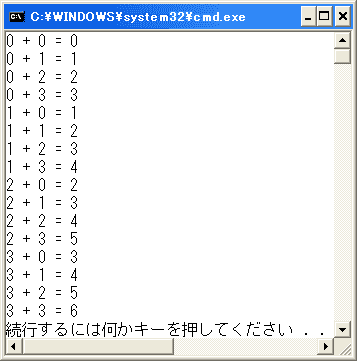
 インデクサも、配列のにように2次元、3次元、...と多次元のものを作ることができます。
インデクサも、配列のにように2次元、3次元、...と多次元のものを作ることができます。
宣言の仕方は、次のように行います。
要素のデータ型 this[int index1, int index2,...]{}
では、早速2次元の場合のサンプルをみてみましょう。
// mindexer01.cs
using System;
class MyClass
{
int[,] array;
public int this[int x, int y]
{
get
{
return array[x, y];
}
set
{
array[x, y] = value;
}
}
public MyClass(int a, int b)
{
array = new int[a, b];
}
}
class mindexer01
{
public static void Main()
{
MyClass mc = new MyClass(4, 4);
for (int i = 0; i < 4; i++)
{
for (int j = 0; j < 4; j++)
{
mc[i, j] = i + j;
}
}
for (int i = 0; i < 4; i++)
{
for (int j = 0; j < 4; j++)
{
Console.WriteLine("{0} + {1} = {2}", i, j, mc[i, j]);
}
}
}
}
使い方は1次元の時と全く同じです。実行結果は次のようになります。

もちろん、多次元インデクサでもインデックスにint型以外のものを使えます。
次の例は、インデックスにstring型とint型を使ったかなり変なプログラムです。 (なお、このプログラムの地名や市外局番は架空のものです)
// mindexer02.cs
using System;
class MyTelephone
{
public string this[string address, int phone]
{
get
{
switch (address)
{
case "北海道":
switch (phone)
{
case 166:
return "旭川市";
case 11:
return "札幌市";
default:
return "知りません";
}
case "東京都":
switch (phone)
{
case 3:
return "23区";
case 422:
return "小金井市";
default:
return "知りません";
}
default:
return "知りません";
}
}
}
}
class mindexer02
{
public static void Main()
{
string strFormat = "{0}で市外局番が{1}は{2}です";
MyTelephone mt = new MyTelephone();
Console.WriteLine(strFormat, "東京都", 3, mt["東京都", 3]);
Console.WriteLine(strFormat, "北海道", 166, mt["北海道", 166]);
Console.WriteLine(strFormat, "九州", 114, mt["九州", 114]);
}
}
これは、変なプログラムですね。まさか、インデクサに電話帳みたいなことをさせるとは
あまり思いつく人はいないでしょう。実行結果は次のようになります。

Update 07/Sep/2006 By Y.Kumei